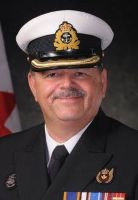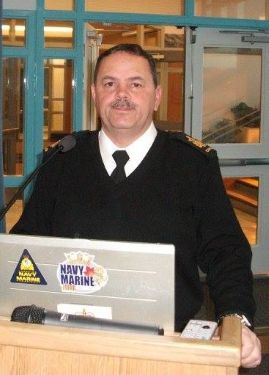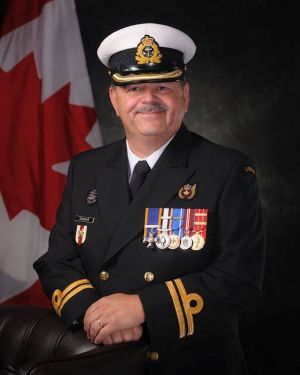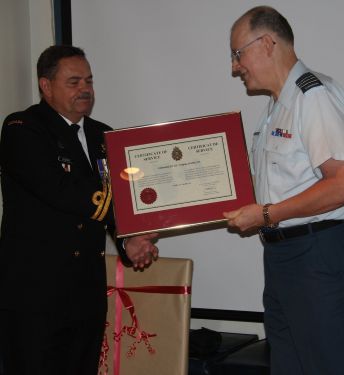|
Service information for:
(Left) CPO1 David Gingras // (Centre) Lt (N) David Gingras // (Right) Lt (N) David Gingras receiving his Certificate of Service.
David Gingras was born to be in the military. Born at Pembroke, ON - the son of a Load Master, Traffic Technician by trade in the RCAF who flew onboard the CC-130 Hercules. David grew up an only child, more attached to his mother during his childhood as his father was away from home frequently on flights. The two would later form an unbreakable bond in his adult years. David lived on different bases growing up, mostly in Trenton, ON where he attended Bayside High School in Belleville, ON. He was a member of the 704 Air Force City Royal Canadian Air Cadet Squadron, attending the rank of Flight Sergeant before quitting the program at 17 to join the regular force of the CF.
One of the postings he had as a child was to Germany, where by chance during a unit Christmas party he met his future wife, although the two didn't know yet. 16 years later in Toronto, ON the two would meet again, when Jacqueline Gingras the daughter of an MWO Traffic Technician was out on a bike ride on base. As she passed by the junior rank's barracks seeing a man leaning out on his balcony being polite, she waved and said "Howdy", the boy from Belleville who grew up riding horses on a farm called her back and the two would marry at Victoria, BC in 1981. Later the couple had two sons, David Jr. and Ryan. Both sons would also serve in the Canadian Forces in Afghanistan.
Enlistment: David Gingras enlisted into the CF on 6 December 1979 at the age of 17. Choosing Infantry as his trade while his father was away during a flight. He was able to have his mother agree to sign off on him enrolling. When his father returned home and found out he called the recruiting centre, he knew the NCO who took Dave's application and told him his son wasn't joining the infantry and asked what trades were open. Given the options his father selected 862 Steward. The application was changed, and Dave didn't learn of this until he arrived for basic training. The 17 year didn't care as he just wanted into the CF.
862 Steward: A Steward was part of the logistics department. It took care of the inventory and supplying the various messes with soft drinks, alcohol, sweets, ship's paraphernalia and other items. The accounting is done by the supervisor of the canteen, and that person works alongside other members of the logistics department.
In terms of food, Stewards served meals to Officers at formal military events. Apart of the Steward trade is serving aboard RCAF passenger aircraft as Flight Stewards. Flight Stewards are skilled at performing a variety of tasks associated with passenger safety and comfort, responding to onboard emergencies, and operating aircraft ancillary, emergency and survival equipment.
Training: Dave completed basic training at Cornwallis on 3 January 1980 with course 8001. Following basic training he was tasked to the Canadian Forces College in Toronto, ON for OJT. He then went to CFB. Borden where he attended the Canadian Forces School of Administration and Logistics (CFSAL). At CFSAL he completed his TQ 3 course qualifying as a Steward and was posted to Victoria, BC after.
Admirals Valet: While in Victoria, BC he stood out for his knowledge and performance of duties from his peers. He was selected to be the Admirals valet, a duty that consisted of serving the Admiral, essentially as his personal aide, including driver.
While in Victoria, BC he also sailed on the HMCS Huron, the frigate was a prominent vessel in the Pacific Fleet during the 1980s. After Victoria, Dave was posted to CFB. Petawawa where he served with 2 Service Battalion and supported the Canadian Airborne Regiment.
2 SVC BN: provides second-line Combat Service Support to 2 CMBG, including Transportation, Supply, and Maintenance to assigned formations for domestic and deployed operations. It also provides essential institutional support to 4th Canadian Division Support Base Petawawa lodger units.
Although not a qualified parachutist, Dave was not there for that function. He served in the CAR to be the Commanding Officer's batman (old army term for aide). He also managed mess dinners and functions in the field for the officers of the regiment as well the canteen. The canteen used to sell and serve beer in the field as well soda, chips, candy bars ect. As morale for the troops.
CAR:The Canadian Airborne Regiment was a Canadian Forces formation created on April 8, 1968. It was not an administrative regiment in the commonly accepted British Commonwealth sense, but rather a tactical formation manned from other regiments and branches. It was disbanded in 1995 after the Somalia affair.
SVC CDO:The Airborne Service Commando was a support unit within the Canadian Airborne Regiment, providing combat service support to the infantry commandos. This unit was part of the larger regiment, which included airborne rifle commandos, headquarters, and signal elements.
While a member of the Service Commando, Dave deployed to RV 89 in Wainwright AB.
RV 89:(Rendezvous 89) was a significant exercise within the Canadian Armed Forces (CAF) in 1989. It was a large-scale field training exercise designed to test and refine various aspects of military operations, including logistics and the deployment of equipment. RV 89 played a crucial role in the development of military doctrine and the integration of different units, highlighting the importance of logistics and the need for innovative approaches in supporting operational success.
Promoted to Master Corporal Dave attended his Junior Leadership Course (JLC) at CFB. Borden, ON. He was posted to Canadian Forces Station CARP where he managed the Canex inside of CARP.
CARP: The Diefenbunker, formerly known by its military designation, Canadian Forces Station Carp (CFS Carp), is a large underground four-storey reinforced concrete bunker and nuclear fallout shelter located in the rural area of Carp, Ontario approximately 30 km (19 mi) west of downtown Ottawa. Between 1957 and 1961, during the Cold Warthe Government of Canada led by then Prime Minister John Diefenbaker authorized the Diefenbunker to be designed and built as the Central Emergency Government Headquarters (CEGHQ Carp) in an attempt to ensure the continuity of government subsequent to a nuclear weapons attack by the Soviet Union. In 1994, CFS Carp was decommissioned and closed.
While a Master Corporal, Dave completed the Flight Steward Course held at CFB. Trenton, qualifying him as a Flight Steward. He was awarded the Badge of Flight Crew of the Canadian Armed Forces. He was never employed in this position, however during his training he flew on the Boeing CC-137 which was the CAF's version of the Boeing 707 transport jet. His flight training was conducted with 437 Husky Squadron.
437 SQN: 8 Wing/Canadian Forces Base Trenton has been home base for 437 Transport Squadron since 1961.
437 Transport Squadron is currently equipped with five CC-150 Polaris aircraft. The Squadron's primary roles are long-range transport of personnel and equipment, air-to-air refueling of fighter aircraft and VIP transport. The Squadron occasionally performs aeromedical evacuation roles as well.
Following CARP, Dave was posted to CFB. Uplands Ottawa at the rank of Sergeant.
CFB Uplands: Canadian Forces Base Uplands (also CFB Uplands) was a Canadian Forces Base located in Ottawa, Ontario. Most of the land which formed the base was transferred to the Ottawa Macdonald-Cartier International Airport after the base was closed in the 1990s. Several military units continue to exist at the former base and the Canadian Forces continues to maintain military housing at the site. The former base is now known formally as "Canadian Forces Support Group (Ottawa-Gatineau) - Uplands Site."
Next after his posting to Uplands he was promoted to Warrant Officer at the age of 28 which I only mention because that is extremely young for that rank in the modern CF. He was posted to the French Language School at CFB. Winnipeg, MB.
CFB. Winnipeg: Canadian Forces Base Winnipeg is a Royal Canadian Air Force base located within the City of Winnipeg, Manitoba. Co-located at Winnipeg James Armstrong Richardson International Airport, CFB Winnipeg is home to many flight operations support divisions, as well as several training schools.
After a brief one year posting he was posted in HMCS Algonquin at Halifax, NS.
HMCS Algonquin: HMCS Algonquin (DDG 283) was an Iroquois-class destroyer that served in the Royal Canadian Navy (RCN) from 1973 to 2015.
Algonquin was the fourth ship of her class which is sometimes referred to as the Tribal class or the 280 class. She is the second vessel to use the designation HMCS Algonquin. Algonquin carried the hull classification symbol DDG.
Algonquin was originally designed to be primarily an anti-submarine destroyer. The Iroquois-class destroyers were the first ships in the Royal Canadian Navy (other than the Protecteur class) to carry multiple helicopters, and were the first ships to be powered entirely by gas turbines in a COGOG (Combined Gas Or Gas) arrangement. Algonquin underwent a major refit called the Tribal Class Update and Modernization Program (TRUMP) from 1987 to 1991 and emerged as an area air defence destroyer.
Dave was posted in the Algonquin as the ships Chief Steward, during listing trials in 1991 causing the ship to take an unplanned 25-degree list to port. The crew were aboard the ship including Dave when the accident occurred. Dave found himself surrounded by Ocean water inside the ship as it took on water. He led members of the crew to patch flood holes and close off other entry points to secure the ship. Meanwhile the crew at the time didn't know the danger that they were in of the ship possibly rolling over in port and trapping the crew in an upside-down warship.
Navy tugboats pushed the ship on one side to brace it as a crane was brought in to hold the ship up as the crew gained control of the situation and pumped out the water.
Listing Trials: After coming out of refit, HMCS ALGONQUIN was conducting alongside trials, which included inclination trials involving "tilting" the ship by flooding ballast tanks. It was discovered (afterwards) that the covers on the tanks were not properly secured and it resulted in major flooding. ALGONQUIN'S damage control teams as well as crews and equipment from other nearby ships managed to stop the flooding and keep her afloat.
Dave later went to sea with the Algonquin when she was called into support a naval blockade of the Former Yugoslavia.
OP Sharp Guard: On 29 March 1993, Algonquin sailed to join STANAVFORLANT, arriving in April. She was once again made flagship and took part in the naval blockade of the former Yugoslavia as part of Operation "Sharp Guard". On 2 July, Algonquin conducted the first of a total of 88 merchant vessel boardings as part of the blockade. On 27 July, the busiest day for Algonquin boarding parties, seven merchant ships were boarded in a 23 hour period. On 1 October, the ship completed her last boarding in support of the operation. On 5 October, Algonquin completed turnover of STANAVFORLANT to HMCS Iroquois and returned home.
*An interesting point about this operation is that the crew of the Algonquin, including Dave were awarded the NATO Former Yugoslavia Medal. This operation did not qualify for the Canadian Peacekeeping Service Medal (CPSM) that is typically always beside the NATO FY Medal. It has caused confusion to others throughout his career often commenting that he was "missing a medal" when in fact he was not.
Also while Dave was posted in HMCS Algonquin he was awarded his Canadian Forces' Decoration at the age of 29 he had already served his country for 12 years.
Dave returned from Operation Sharp Guard and was posted to CFB. Edmonton in 1994 to become the base Officer Mess Manger.
CFB. Edmonton: also known as the 3rd Canadian Division Support Base Edmonton or Edmonton Garrison, is a Canadian Forces base located just north of Edmonton, Alberta. It serves as the headquarters for the 3rd Canadian Division and 1st Canadian Mechanized Brigade Group. The base is situated in Sturgeon County and encompasses the military base and the community of Lancaster Park.
While posted to Edmonton, Dave ran for and was voted in to be the Mayor of Lancaster Park. He held the position until he was promoted to Master Warrant Officer on 14 June 1995. At the time of his promotion, he was the youngest MWO in the entire Logistics Branch at age 33. He was then posted to CFB. Toronto as the Canadian Forces College Sergeant Major.
Canadian Forces College: is a military staff college for senior and general officers of the Canadian Armed Forces. It provides graduate-level military education courses designed to develop leadership abilities within the Canadian Forces in a whole-of-government framework.
While serving as the staff college Sergeant Major, Dave reported directly to the Commandant, Brigadier General Edward Gosden, CMM, CD. Dave's youngest son, Ryan was a member of 188 Cobra SQN, Royal Canadian Air Cadets while the family was posted to Toronto.
Dave, a former Cadet himself, and at the time wearing the DEU of the Air Force (it is not uncommon for purple trades to switch elements, during Dave's career he wore all three element uniforms of the Army, Air Force and Navy). He had taken an interest in volunteering with his son's Cadet squadron that paraded out of the old transport building at CFB. Toronto.
Upon hearing of Dave's involvement with the Cadets, the General a pilot by trade after the Canadian Force College and his support. The General and Sergeant Major (Dave) would put on weekend training for the senior NCOs of the Cadet Squadron. Together they taught various leadership lessons throughout the weekend that ended with a mess dinner, after Dave taught the Cadets mess etiquette.
During the Annual Cadet Review (ACR) Dave gave the Cadets drill instructions and organized the parade. General Gosden, CMM, CD would volunteer as reviewing officer for the parades.
The General was so impressed by Dave's professionalism, leadership and dedication to the College as Sergeant Major, the CAF and Cadets that he recommended Dave for the ORMM.
Member-Order of Military Merit (MMM): GINGRAS, David Louis, MWO, Toronto. Canada Gazette: 15 March 1997
Shortly after the award of his ORMM the Steward Trade became a hard navy trade of the RCN. Dave was issued the Navy DEU, and his rank title was changed from Master Warrant Officer to Chief Petty Officer 2nd Class.
He was posted back to CFB. Halifax, this time to the base proper at Stadacona and not a war ship. He managed the base accommodations during this posting.
Stadacona: Canadian Forces Base (CFB) Halifax is Canada's east coast naval base and home port to the Royal Canadian Navy Atlantic fleet, known as Canadian Fleet Atlantic (CANFLTLANT), that forms part of the formation Maritime Forces Atlantic (MARLANT).
It is the largest Canadian Forces Base in terms of the number of posted personnel and is formed from an amalgamation of military properties situated around the strategic Halifax Harbour in Nova Scotia.
CFPSA: After his posting to Halifax in 2001 he was posted to Ottawa, ON to work for CPSA as the National Hospitality Services Officer. He was responsible for all CAF messes, Golf and Curling Clubs. He was also double hated as the Chief for General Langton, CEO of CFPSA.
While at CFPSA in Ottawa, Dave was appointed the first Welfare Officer, on 11 July 2003, for Roto 0 to Kabul, Afghanistan. Dave was located in Dubai at Camp Mirage.
Op Athena: began on 17 July 2003 with the installation of Brigadier-General Peter Devlin of Canada for a six-month tour in command of ISAF's Kabul Multi-National Brigade. On 19 July 2003, the 3rd Battalion, The Royal Canadian Regiment Battalion Group, began deploying to Kabul as Roto 0 of Task Force Kabul.
ISAF became a NATO mission on 11 August 2003. On the same day, Major-General Andrew Leslie of Canada was installed as Deputy Commander of ISAF in Kabul. Its main focus during the first year of NATO leadership was helping the Afghan Transitional Authority maintain a safe and secure environment in Kabul while the Loya Jirga developed and ratified a constitution for Afghanistan (completed 4 January 2004).
On 9 February 2004, Lieutenant-General Rick Hillier of Canada accepted the command of ISAF, which he retained until handing over to LGen Jean-Louis Py of France on 9 August 2004.
ISAF's primary objective in 2004 was ensuring the safe conduct of Afghanistan's first democratic election, which was held on 9 October 2004 to choose 250 Members of Parliament and the President. Despite widespread threats and isolated outbreaks of violence, some 80 percent of eligible voters turned out on election day. Hamid Karzai was declared the winner, and on 9 December 2004 he was inaugurated President of the Islamic Republic of Afghanistan.
Camp Mirage: is the codename for a former Canadian Forces forward logistics facility located in Dubai, United Arab Emirates. The facility was established in late-December 2001 and though not officially acknowledged by the Canadian Forces, is considered an "secret".
Dave took with him the first group of Non-Profit Funds (NPF) employees to a theatre of war, while bouncing back and forth between Dubai and Camp Julien in Kabul. He set up a Canex (Canadian Forces Exchange Store), barber shops, HLTA travel and gyms in both Dubai and Kabul, Afghanistan.
CPO1: On 27 February 2007, Dave was promoted to Chief Petty Officer 1st Class (CPO1). The highest rank a non-commissioned member can be promoted to in the CAF. Following his promotion he was posted to Ottawa's DGMC.
DGMC: Director General Military Careers is where Dave became Career Manager (CM) for the Steward Trade until 2011.
Commission: Dave was commissioned from the ranks (CFR) on 4 July 2011. With a promotion to Lieutenant (Navy). He was subsequently posted to Director General Personnel and Family Support Services (DGPFSS), Ottawa. The Steward Trade does not have Officers; Dave was required to select a new trade to commission. He selected Maritime Surface and Sub-Surface Officer (MARS).
Retirement: Lieutenant (Navy) David Louis Gingras, MMM, CD retired from the CAF in 2015 after serving his country for 36 years. He and his wife retired to Embrun, ON. During his retirement from the CAF, Dave continued his education earning a university degree.
Medals Awarded: Member-Order of Military Merit (MMM), Southwest Asia Service Medal w/ Afghanistan Bar, NATO Former Yugoslavia Medal, Queen Eilzabeth II Diamond Jubilee Medal and Canadian Forces' Decoration w/ 2nd Clasp.
Legacy:Lieutenant (Navy) David Louis Gingras, MMM, CD encouraged both sons to serve in the Canadian Forces. Both sons also participated in the Afghanistan War. David Jr. an RCAF aircrew member of the CC-117 Globemaster, AVN Tech by trade. David Jr. was based out of Camp. Mirage and flew frequent missions into KAF, Afghanistan delivering troops and supplies. Ryan was an Infantry soldier with the Royal Canadian Regiment. He fought with 1 RCR Charles Company during Operation Medusa in Kandahar Afghanistan.
The families service during the Afghanistan war of father and sons contributed to the war effort of Canada's longest War. Dave's legacy is also in his four grandchildren who will carry on the family name.
NULLI SECUNDUS
|




